2023 SUBARU BRZ check engine
[x] Cancel search: check enginePage 251 of 432
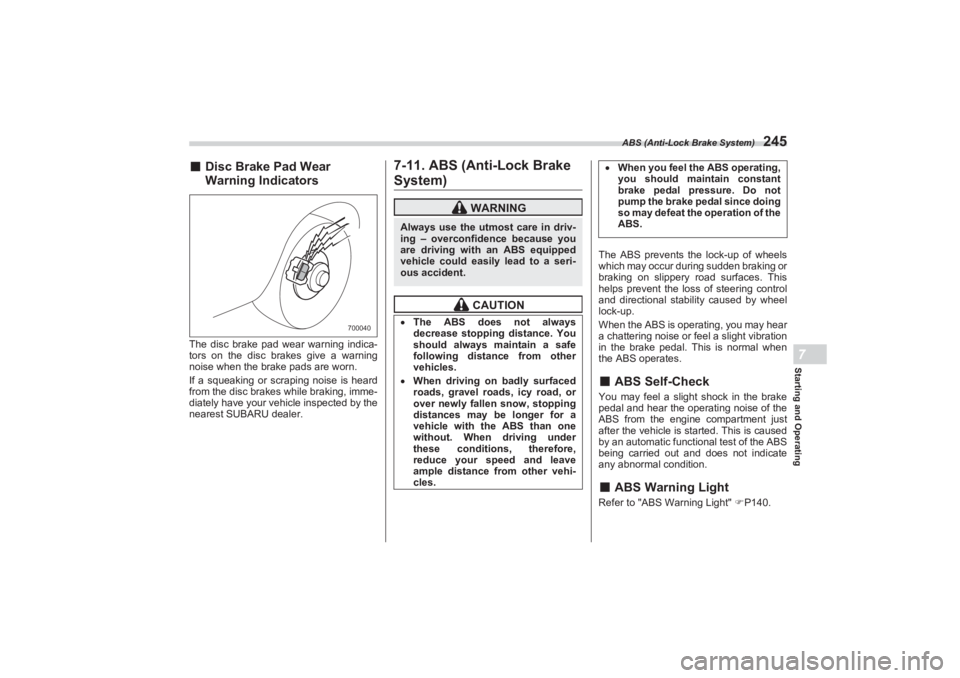
ABS (Anti-Lock Brake System)
245
Starting and Operating7
■Disc Brake Pad Wear
Wa rning IndicatorsThe disc brake pad wear warning indica-
tors on the disc brakes give a warning
noise when the brake pads are worn.
If a squeaking or scraping noise is heard
from the disc brakes while braking, imme-
diately have your vehicle inspected by the
nearest SUBARU dealer.
7-11. ABS (Anti-Lock BrakeSystem)
The ABS prevents the lock-up of wheels
which may occur during sudden braking or
braking on slippery road surfaces. This
helps prevent the loss of steering control
and directional stability caused by wheel
lock-up.
When the ABS is operating, you may hear
a chattering noise or f eel a slight vibration
in the brake pedal. This is normal when
the ABS operates.■ ABS Self-CheckYou may feel a slight shock in the brake
pedal and hear the operating noise of the
ABS from the engine compartment just
after the vehicle is started. This is caused
by an automatic functional test of the ABS
being carried out and does not indicate
any abnormal condition.■ ABS Warning LightRefer to "ABS Warning Light" P140.
700040
WARNING
Always use the utmost care in driv-
ing – overconfidence because you
are driving with an ABS equipped
vehicle could easily lead to a seri-
ous accident.
CAUTION
The ABS does not always
decrease stopping distance. You
should always maintain a safe
following distance from other
vehicles. When driving on badly surfaced
roads, gravel roads, icy road, or
over newly fallen snow, stopping
distances may be longer for a
vehicle with the ABS than one
without. When driving under
these conditions, therefore,
reduce your speed and leave
ample distance from other vehi-
cles.
When you feel the ABS operating,
you should maintain constant
brake pedal pressure. Do not
pump the brake pedal since doing
so may defeat the operation of the
ABS.
BRZ_U.book 245 ページ 2022年3月29日 火曜日 午後3時59分
Page 261 of 432

Parking Your Vehicle
255
Starting and Operating7
– CONTINUED –
■When Initialization of the Tire
Pressure Monitoring System
has FailedInitialization can be completed in a few
minutes. However, in the following case,
the settings have not been recorded and
the system will not o perate properly. If
repeated attempts to record tire inflation
pressure settings ar e unsuccessful, have
the vehicle checked at your SUBARU
dealer.
When operating the TPMS set switch,
low tire pressure warning light does not
blink 3 times.
After carrying out the initialization
procedure, the low tire pressure warning
light blinks for 1 minute then stays on after
driving for 20 minutes.
■ Registering ID CodesEvery tire pressure warning valve and
transmitter has a unique ID code. In addi-
tion to the set of tire pressure monitoring
system sensor ID code s initially registered
to the vehicle, a second set of ID codes
can be registered.
A second set of tire pressure monitoring
system sensor ID codes can be registered
at your SUBARU dealer. When 2 sets of
ID codes have been registered, either ID
code set can be selected.■ Changing the ID code set1. Park the vehicle in a safe place and
turn the ignition swit ch to the “ON” posi-
tion.
2. Press the TPMS set switch 3 times
within 3 seconds.
3. The low tire pressure warning light will
illuminate for 3 seconds and then blink 3
times.
4. The low tire pressure warning light will
blink for 1 minute and then illuminate.
5. When the ID code change has
completed, the tire pressure monitoring
light will turn off.
Check that tire pressures are displayed on
the TPMS screen.
7-16. Parking Your Vehicle■ Parking BrakeTo set the parking brake, depress the
brake pedal firmly and hold it down until
the parking brake lever is fully pulled up.
WARNING
Do not operate the TPMS set switch
without first adjust ing the tire infla-
tion pressure to the specified level.
Otherwise, the low tire pressure
warning light may not come on even
if the tire inflation pressure is low,
or it may come on when the tire
inflation pressure is actually nor-
mal.
WARNING
Never leave unattended children
or pets in the vehicle. They could
accidentally injure themselves or
others through inadvertent oper-
ation of the vehicle. Also, on hot
or sunny days, the temperature in
a closed vehicle could quickly
become high enough to cause
severe or possibly fatal injuries to
people. Do not park the vehicle over flam-
mable materials such as dry
grass, waste paper or rags, as
they may burn easily if they come
near hot engine or exhaust
system parts. Be sure to stop the engine if you
take a nap in the vehicle. If engine
exhaust gas enters the passenger
compartment, occupants in the
vehicle could die from carbon
monoxide (CO) contained in the
exhaust gas.
BRZ_U.book 255 ページ 2022年3月29日 火曜日 午後3時59分
Page 297 of 432
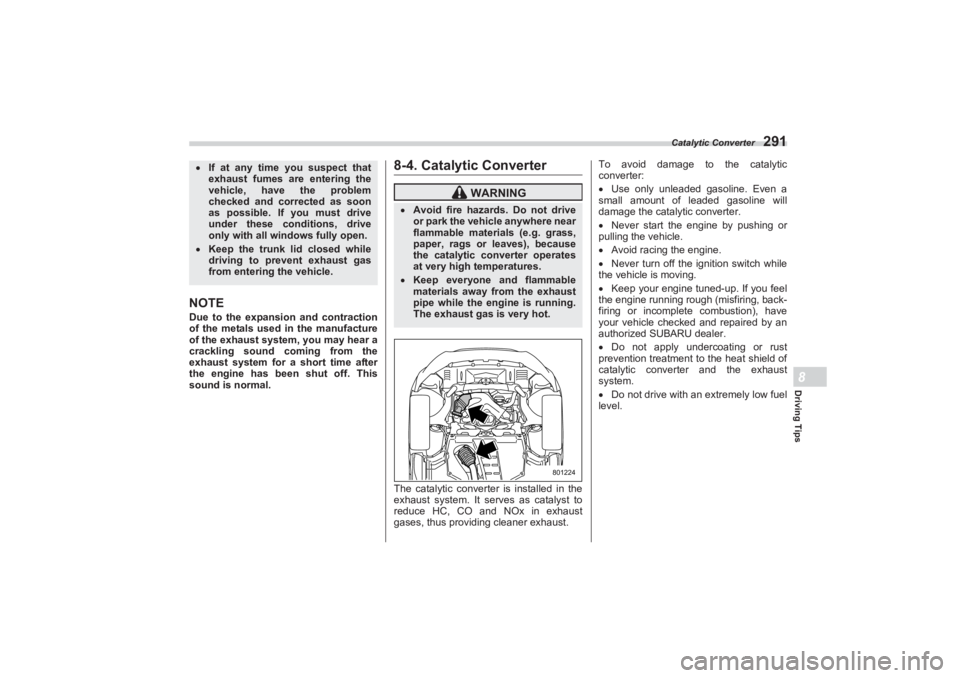
Catalytic Converter
291
Driving Tips8
NOTEDue to the expansion and contraction
of the metals used in the manufacture
of the exhaust system, you may hear a
crackling sound coming from the
exhaust system for a short time after
the engine has been shut off. This
sound is normal.
8-4. Catalytic ConverterThe catalytic converter is installed in the
exhaust system. It serves as catalyst to
reduce HC, CO and NOx in exhaust
gases, thus providing cleaner exhaust. To avoid damage to the catalytic
converter:
Use only unleaded gasoline. Even a
small amount of leaded gasoline will
damage the catalytic converter.
Never start the engine by pushing or
pulling the vehicle.
Avoid racing the engine.
Never turn off the ig nition switch while
the vehicle is moving.
Keep your engine tuned-up. If you feel
the engine running rough (misfiring, back-
firing or incomplete combustion), have
your vehicle checked and repaired by an
authorized SUBARU dealer.
Do not apply undercoating or rust
prevention treatment to the heat shield of
catalytic converter and the exhaust
system.
Do not drive with an extremely low fuel
level.
If at any time you suspect that
exhaust fumes are entering the
vehicle, have the problem
checked and corrected as soon
as possible. If you must drive
under these conditions, drive
only with all windows fully open. Keep the trunk lid closed while
driving to prevent exhaust gas
from entering the vehicle.
WARNING
Avoid fire hazards. Do not drive
or park the vehicle anywhere near
flammable materi als (e.g. grass,
paper, rags or leaves), because
the catalytic converter operates
at very high temperatures. Keep everyone and flammable
materials away from the exhaust
pipe while the engine is running.
The exhaust gas is very hot.
801224
BRZ_U.book 291 ページ 2022年3月29日 火曜日 午後3時59分
Page 299 of 432
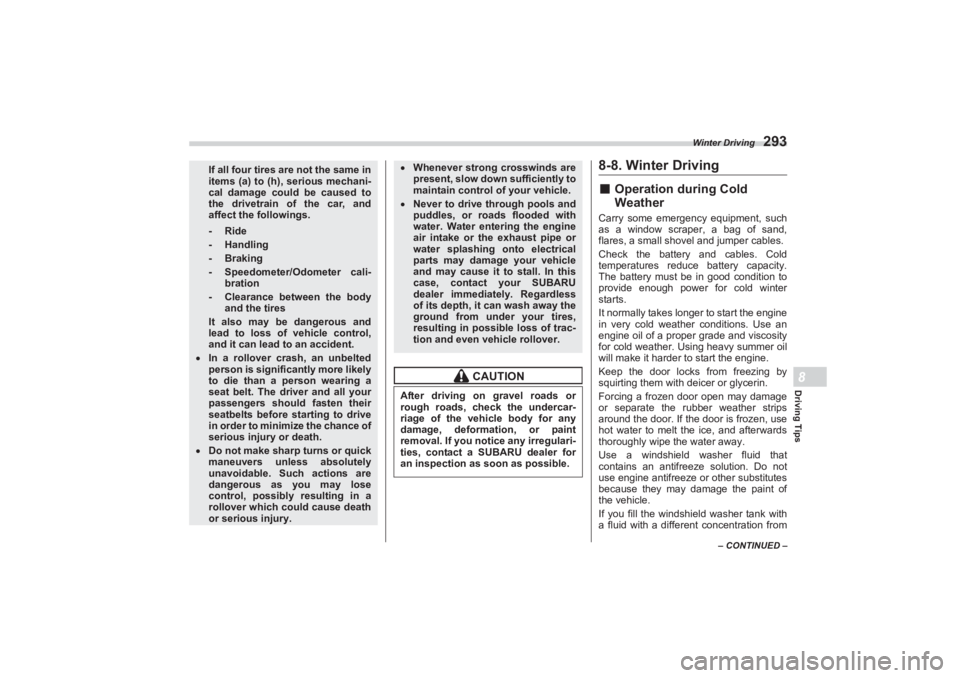
Winter Driving
293
Driving Tips8
– CONTINUED –
8-8. Winter Driving■Operation during Cold
WeatherCarry some emergency equipment, such
as a window scraper, a bag of sand,
flares, a small shovel and jumper cables.
Check the battery and cables. Cold
temperatures reduce battery capacity.
The battery must be in good condition to
provide enough power for cold winter
starts.
It normally takes longer to start the engine
in very cold weather conditions. Use an
engine oil of a proper grade and viscosity
for cold weather. Using heavy summer oil
will make it harder to start the engine.
Keep the door locks from freezing by
squirting them with deicer or glycerin.
Forcing a frozen door open may damage
or separate the rubber weather strips
around the door. If the door is frozen, use
hot water to melt the ice, and afterwards
thoroughly wipe the water away.
Use a windshield washer fluid that
contains an antifr eeze solution. Do not
use engine antifreeze or other substitutes
because they may damage the paint of
the vehicle.
If you fill the windshield washer tank with
a fluid with a different concentration from
If all four tires are not the same in
items (a) to (h), serious mechani-
cal damage could be caused to
the drivetrain of the car, and
affect the followings.-Ride-Handling- Braking- Speedometer/Odometer cali-
bration- Clearance between the body
and the tires
It also may be dangerous and
lead to loss of vehicle control,
and it can lead to an accident.
In a rollover crash, an unbelted
person is significantly more likely
to die than a person wearing a
seat belt. The driver and all your
passengers should fasten their
seatbelts before st arting to drive
in order to minimize the chance of
serious injury or death. Do not make sharp turns or quick
maneuvers unless absolutely
unavoidable. Such actions are
dangerous as you may lose
control, possibly resulting in a
rollover which could cause death
or serious injury.
Whenever strong crosswinds are
present, slow do wn sufficiently to
maintain control of your vehicle. Never to drive through pools and
puddles, or roads flooded with
water. Water entering the engine
air intake or the exhaust pipe or
water splashing onto electrical
parts may damage your vehicle
and may cause it to stall. In this
case, contact your SUBARU
dealer immediat ely. Regardless
of its depth, it can wash away the
ground from under your tires,
resulting in possible loss of trac-
tion and even vehicle rollover.
CAUTION
After driving on gravel roads or
rough roads, check the undercar-
riage of the vehicle body for any
damage, deformation, or paint
removal. If you notice any irregulari-
ties, contact a SUBARU dealer for
an inspection as soon as possible.
BRZ_U.book 293 ページ 2022年3月29日 火曜日 午後3時59分
Page 300 of 432
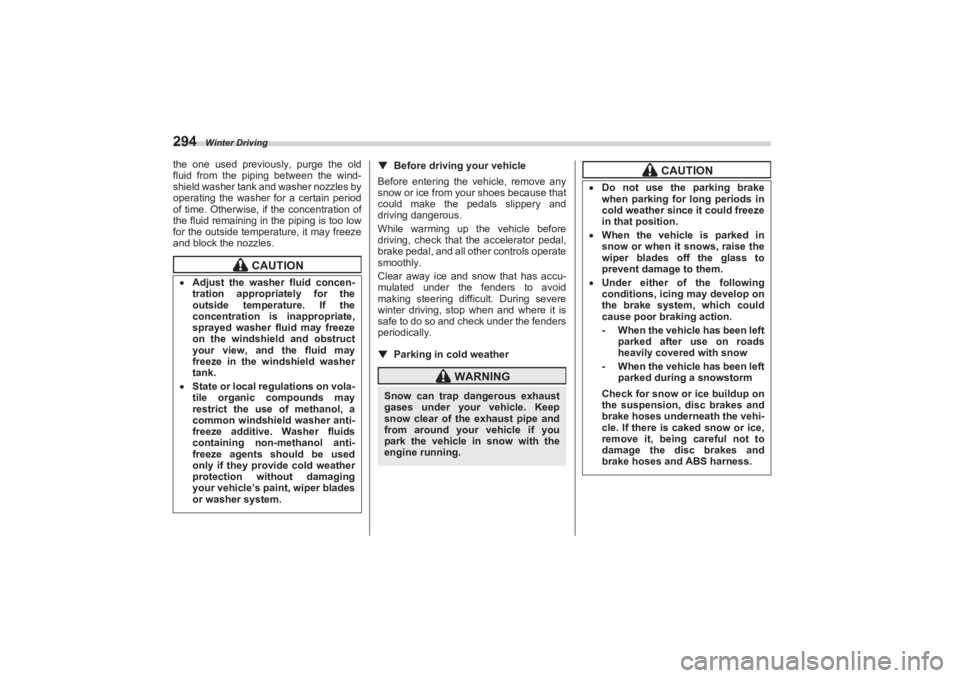
Winter Driving
294the one used previously, purge the old
fluid from the piping between the wind-
shield washer tank and washer nozzles by
operating the washer for a certain period
of time. Otherwise, if the concentration of
the fluid remaining in the piping is too low
for the outside temperature, it may freeze
and block the nozzles.
▼ Before driving your vehicle
Before entering the vehicle, remove any
snow or ice from your shoes because that
could make the pedals slippery and
driving dangerous.
While warming up the vehicle before
driving, check that the accelerator pedal,
brake pedal, and all other controls operate
smoothly.
Clear away ice and snow that has accu-
mulated under the fenders to avoid
making steering difficult. During severe
winter driving, stop when and where it is
safe to do so and check under the fenders
periodically.
▼ Parking in cold weather
CAUTION
Adjust the washer fluid concen-
tration appropriately for the
outside temperature. If the
concentration is inappropriate,
sprayed washer fluid may freeze
on the windshield and obstruct
your view, and the fluid may
freeze in the windshield washer
tank. State or local regulations on vola-
tile organic compounds may
restrict the use of methanol, a
common windshield washer anti-
freeze additive. Washer fluids
containing non-methanol anti-
freeze agents should be used
only if they provide cold weather
protection without damaging
your vehicle’s paint, wiper blades
or washer system.
WARNING
Snow can trap dangerous exhaust
gases under your vehicle. Keep
snow clear of the exhaust pipe and
from around your vehicle if you
park the vehicle in snow with the
engine running.
CAUTION
Do not use the parking brake
when parking for long periods in
cold weather since it could freeze
in that position. When the vehicle is parked in
snow or when it snows, raise the
wiper blades off the glass to
prevent damage to them. Under either of the following
conditions, icing may develop on
the brake system, which could
cause poor braking action.
- When the vehicle has been left
parked after use on roads
heavily covered with snow- When the vehicle has been left
parked during a snowstormCheck for snow or ice buildup on
the suspension, disc brakes and
brake hoses underneath the vehi-
cle. If there is caked snow or ice,
remove it, being careful not to
damage the disc brakes and
brake hoses and ABS harness.
BRZ_U.book 294 ページ 2022年3月29日 火曜日 午後3時59分
Page 325 of 432
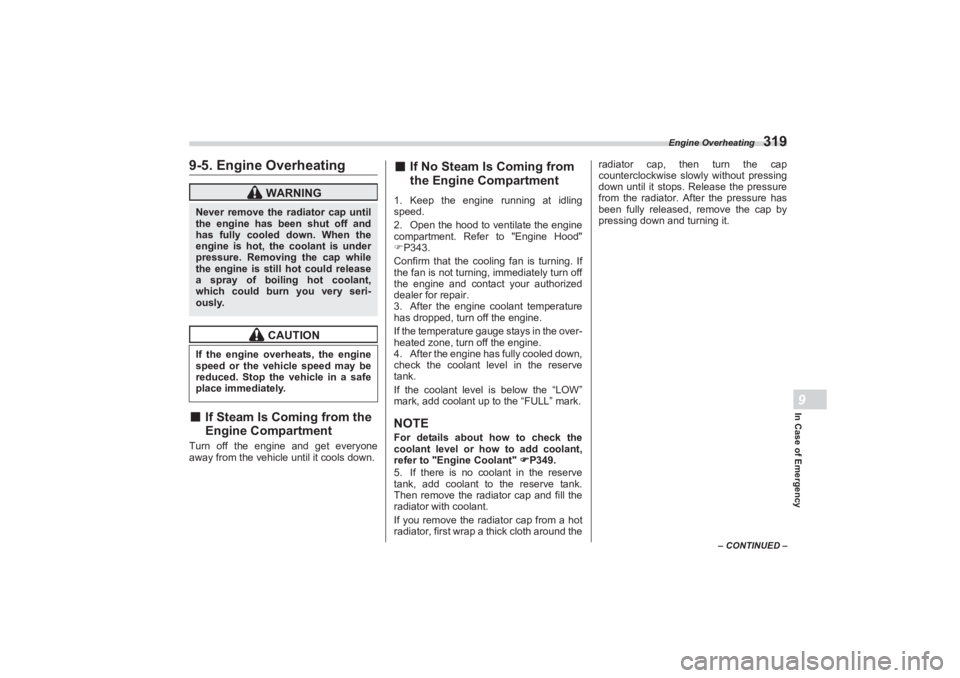
Engine Overheating
319
In Case of Emergency9
– CONTINUED –
9-5. Engine Overheating■If Steam Is Coming from the
Engine CompartmentTurn off the engine and get everyone
away from the vehicle until it cools down.
■ If No Steam Is Coming from
the Engine Compartment1. Keep the engine running at idling
speed.
2. Open the hood to ventilate the engine
compartment. Refer to "Engine Hood"
P343.
Confirm that the cooling fan is turning. If
the fan is not turning, immediately turn off
the engine and contact your authorized
dealer for repair.
3. After the engine coolant temperature
has dropped, turn off the engine.
If the temperature gauge stays in the over-
heated zone, turn off the engine.
4. After the engine has fully cooled down,
check the coolant level in the reserve
tank.
If the coolant level is below the “LOW”
mark, add coolant up to the “FULL” mark.NOTEFor details about how to check the
coolant level or how to add coolant,
refer to "Eng ine Coolant" P349.
5. If there is no coolant in the reserve
tank, add coolant to the reserve tank.
Then remove the radiator cap and fill the
radiator with coolant.
If you remove the radiator cap from a hot
radiator, first wrap a thick cloth around the radiator cap, then turn the cap
counterclockwise slowly without pressing
down until it stops. Release the pressure
from the radiator. After the pressure has
been fully released, remove the cap by
pressing down and turning it.
WARNING
Never remove the radiator cap until
the engine has been shut off and
has fully cooled down. When the
engine is hot, the coolant is under
pressure. Removing the cap while
the engine is still hot could release
a spray of boiling hot coolant,
which could burn you very seri-
ously.
CAUTION
If the engine overheats, the engine
speed or the vehicle speed may be
reduced. Stop the vehicle in a safe
place immediately.
BRZ_U.book 319 ページ 2022年3月29日 火曜日 午後3時59分
Page 330 of 432

Towing
324holes, return the plugs to their original
places.■Using a Flat-Bed Truck
This is the best way to transport your
vehicle. Use the following procedures to
ensure safe transportation.
1. Shift the select lever into the “P” posi-
tion for AT models. Sh ift the shift lever into
the 1st position for MT models.
2. Apply the parking brake firmly.
3. Secure the vehicle onto the carrier
properly with safety chains. Each safety
chain should be equally tightened and
care must be taken not to pull the chains
so tightly that the suspension bottoms out.
■ Towing with All Wheels on
the Ground
WARNING
Use the rear tie-down holes only for
downward anchoring. If they are
used to anchor the vehicle in any
other direction, cables may slip out
of the holes, possibly causing a
dangerous situation.
900488
CAUTION
Transport by flat -bed truck may
cause the headlights to become
misaligned. In such a case, have the
headlight alignment checked by a
SUBARU dealer after transporting
the vehicle by flat-bed truck.
WARNING
Never turn the ignition switch to
the “OFF” position while the
vehicle is being towed because
the steering wheel and the direc-
tion of the wheels will be locked. Remember that the brake booster
and power steering do not func-
tion when the engine is not
running. Because the engine is
turned off, it w ill take greater
effort to operate the brake pedal
and steering wheel.
900489
BRZ_U.book 324 ページ 2022年3月29日 火曜日 午後3時59分
Page 343 of 432

Maintenance and Service11
Maintenance and Service
11-1. Maintenance Schedule .....................................339
11-2. Maintenance Precautions.................................339
Before Checking or Servicing in the Engine
Compartment ..............................................................340
When Checking or Servicing in the Engine Compartment ..............................................................340
When Checking or Servicing in the Engine Compartment While the Engine Is Running ............341
11-3. Maintenance Tips ..............................................341
Removing and Reinstalling Clips................................341
11-4. Engine Hood ......................................................343
11-5. Engine Compartment Overview.......................345
11-6. Engine Oil ..........................................................346
Engine Oil Consumption..............................................346
Checking the Oil Level .................................................346
Changing the Oil and Oil Filter ....................................347
Recommended Grade and Viscosity ..........................347
Synthetic Oil..................................................................348
11-7. Cooling System .................................................348
Cooling Fan, Hose and Connections ..........................348
Engine Coolant .............................................................349
11-8. Air Cleaner Element ..........................................350
Replacing the Air Cleaner Element .............................350
11-9. Spark Plugs .......................................................352
Recommended Spark Plugs ........................................352
11-10. Drive Belt .........................................................352
11-11. Automatic Transmission Fluid ......................352
Recommended Grade and Viscosity ..........................352
11-12. Differential Gear Oil ........................................353
Recommended Grade and Viscosity ..........................353
11-13. Manual Transmission Oil ...............................353
Recommended Grade and Viscosity ..........................353
11-14. Brake Fluid ......................................................353
Checking the Fluid Level ............................................ 353
Recommended Brake Fluid ........................................ 354
11-15. Clutch Fluid (MT models) ...............................354
Checking the Fluid Level ............................................ 354
Recommended Clutch Fluid ....................................... 355
11-16. Brake Booster .................................................355
11-17. Brake Pedal .....................................................356
11-18. Clutch Pedal (MT models) ..............................356
11-19. Replacement of Brake Pad and Lining..........356
Breaking-in of New Brake Pads and Linings ............ 357
11-20. Parking Brake Stroke ......................................357
11-21. Tires and Wheels ............................................358
Types of Tires .............................................................. 358
Tire Pressure Monito ring System (TPMS)
(If Equipped)............................................................... 358
Tire Inspection ............................................................. 360
Tire Pressures and Wear............................................. 361
Wheel Balance ............................................................. 363
Wear Indicators ............................................................ 363
Rotational Direction of Tires....................................... 364
Tire Rotation................................................................. 364
Tire Replacement ...... ............................. ...................... 365
Wheel Replacement ..................................................... 365
11-22. Alloy Wheels ....................................................366
11-23. Windshield Washer Fluid ...............................366
11-24. Replacement of Wiper Blades........................367
Windshield Wiper Blade Assembly ............................ 368
Windshield Wiper Blade Rubber ................................ 369
11-25. Battery ..............................................................370
11-26. Fuses ................................................................371
11-27. Installation of Acce ssories ............................373
BRZ_U.book 337 ページ 2022年3月29日 火曜日 午後3時59分